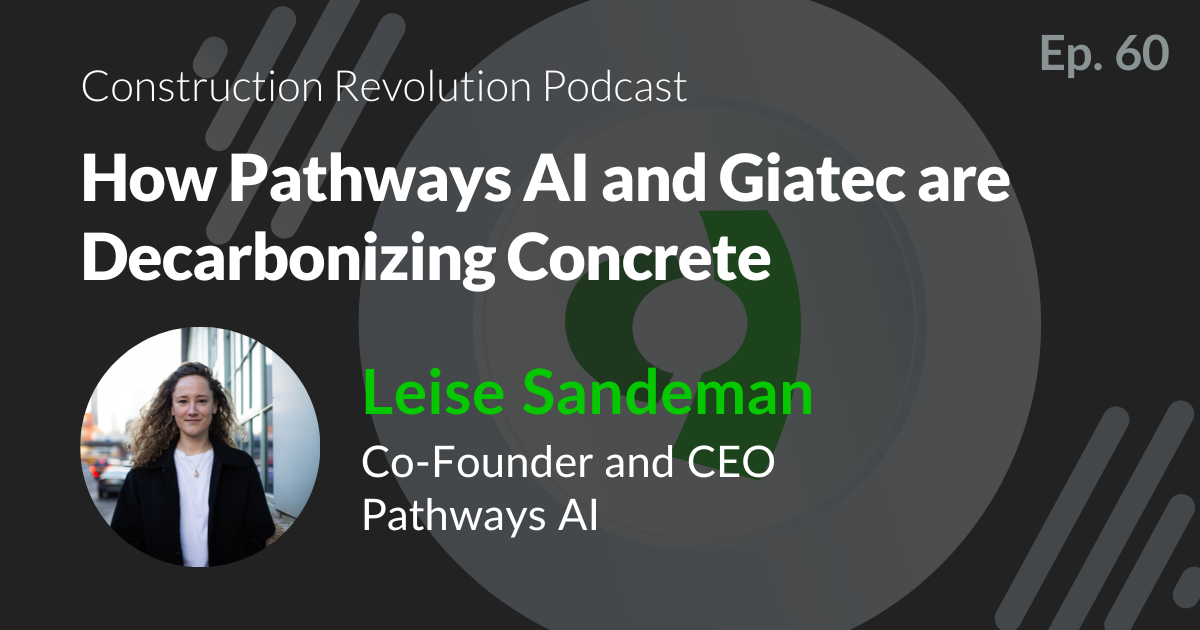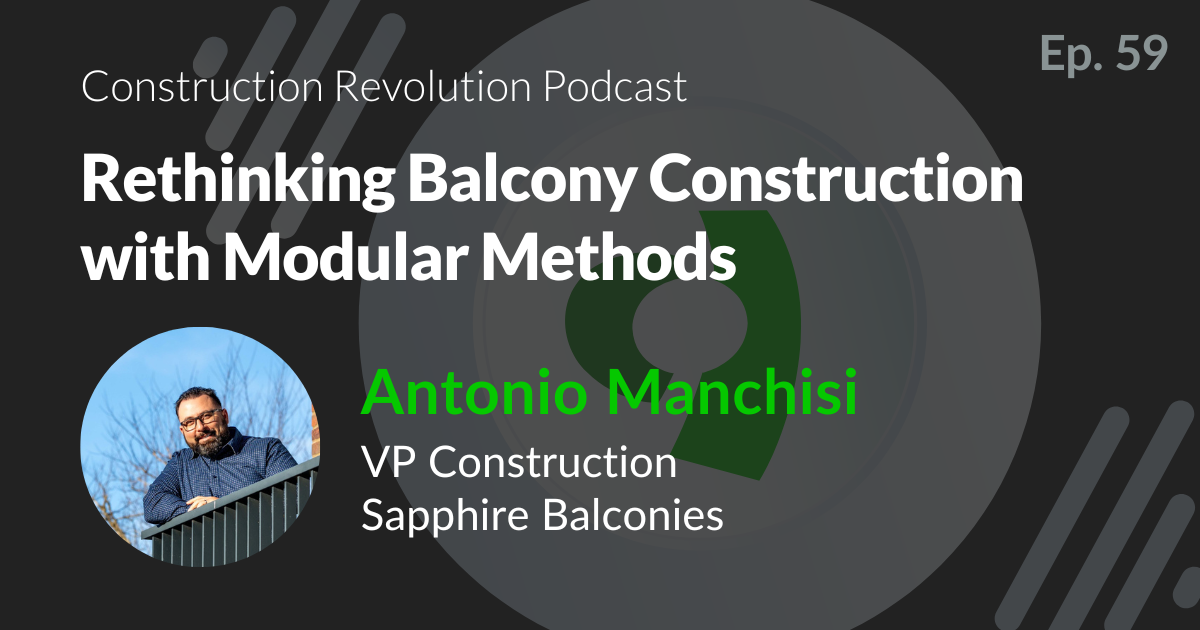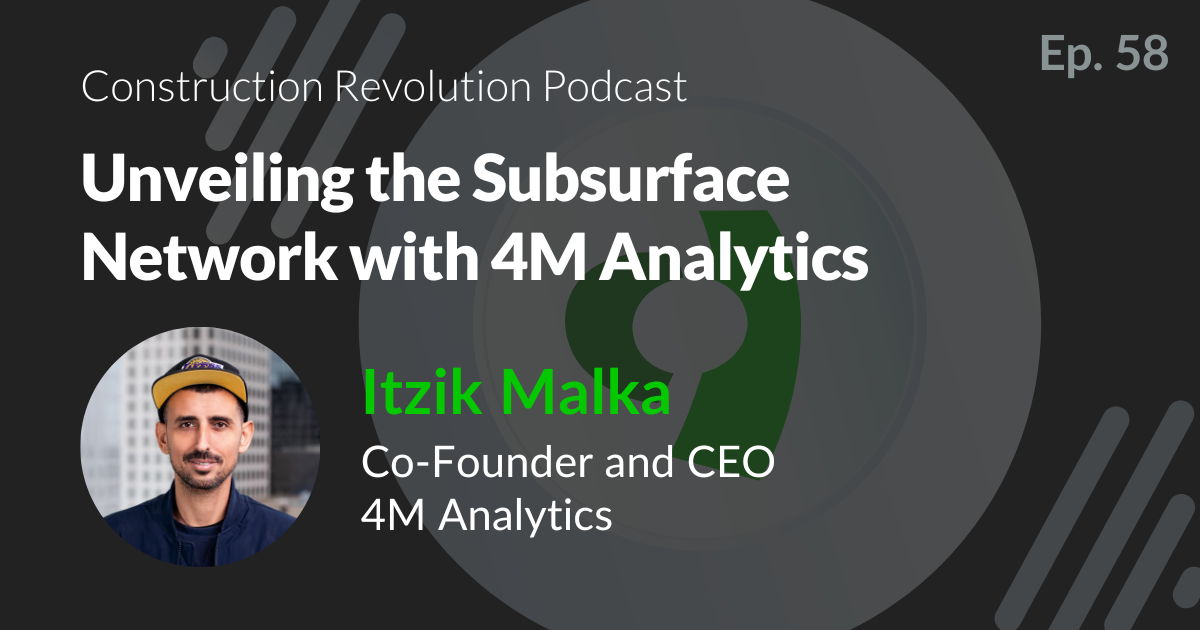
Episode 61 |
October 16, 2025
From Bid to Build: Contract Intelligence for Construction
Subscribe to the Construction Revolution Podcast on Your Favorite Platform:
In This Episode
In Giatec’s episode of The Construction Revolution Podcast, we’re joined by Josh Levy, CEO from Document Crunch. We explore how contract intelligence helps contractors and trade partners simplify complex documents, standardize risk reviews, and make faster decisions from bid through preconstruction and active construction. Josh explains why inconsistent documents and weak administration drive most disputes, and how AI can deliver real-time guidance to field teams to prevent issues before they escalate. We also discuss Document Crunch’s growing dataset, recent gains in specification analysis, and a roadmap toward proactive, transparent risk management that strengthens relationships across owners, GCs, trades, designers, and insurers.

Host
Steven Rossi-Zalmons
Marketing & Events Lead, Giatec Scientific Inc.

Guest
Josh Levy
CEO & Co-Founder, Document Crunch
Podcast Transcript
Steven Rossi:
Hello there and welcome to the Construction Revolution podcast. My name is Steven Rossi, and here on the show we explore the latest trends, technologies, people, and organizations that are revolutionizing or disrupting the construction industry and are changing what the industry will look like tomorrow. Today we’re excited to welcome Josh Levy, co-founder and CEO of Document Crunch, a contract intelligence platform transforming how construction professionals understand and manage risk.
With a background in construction law and a passion for innovation, Josh has helped lead Document Crunch to become a trusted tool for thousands of projects across North America. Join us as we explore how Document Crunch is leveraging AI to simplify complex contracts, reduce disputes, and empower teams to make smarter decisions faster and with greater confidence.
Hi Josh, thanks for joining us today. How are you doing?
Josh Levy:
I’m good. How are you today, Steven?
Steven Rossi:
I’m doing well. I’m excited to learn more about Document Crunch and hear your story. I’ve seen the company at lots of trade shows, so I’m excited to finally learn more about it.
Josh Levy:
I’m excited to tell you about it. It’s one of my favorite things to talk about other than my favorite sports teams or my family. I think this is at the top of my list.
Steven Rossi:
That’s good to hear. So why don’t we start off, and you can tell me the story of how you started Document Crunch and where you got the idea for the company.
Josh Levy:
Yeah, absolutely. I didn’t come to this with a technology background. I have been in the construction industry my whole career. I started out in undergrad at the University of Florida, Gators, as a construction management major and decided I didn’t want to be a project manager after working with a bunch of big general contractors.
So I did what a lot of confused kids do in the U.S., and I went to law school. Even though I tried to broaden my horizons, when I graduated law school in 2010 the economy was in the tank. But there was one very hot area in South Florida where I was living. I had graduated from the University of Miami, and that was construction litigation.
During the bubble leading up to 2010, all these buildings were built in the Miami area, and they were in litigation. So that construction degree became a lottery ticket for me because none of my peers could get jobs coming out of law school. I landed a great job at a great law firm doing construction litigation work. That practice, exclusive construction practice, quickly evolved over time to me starting to handle more of the day-to-day in-project issues that were arising on behalf of big clients, and then continued to evolve into a transactional practice where I was negotiating and assessing risk on the front end of projects. So that skill set, or that practice, was very attractive for me to make the leap to go in-house. And so 10 years ago,
J.E. Dunn Construction, an E E&R top 20 contractor based in Kansas City, but with a really big footprint in the Southeast, brought me to Atlanta. This is in that 2015 timeframe. So I went in-house there. Like a lot of construction companies, J.E. Dunn was growing like a weed coming out of that downturn. The 2010 downturn was still in full force and effect. By about 2013, 2014, things started opening up again,
and these construction companies were all going gangbusters. So it was a period of high growth at J.E. Dunn, and I really got embedded in the business side, applying the skill set that I gained in private practice but being more tightly coupled to the business. I had growth at J.E. Dunn, and the business grew a lot. I found myself running the legal department in the Southeast, and revenue was going up, and all of our bid activity was going up.
We needed to hire more resources to work with me, and I was overwhelmed with the deal flow, frankly. So I started reading about this stuff called artificial intelligence about seven, eight years ago and how law firms were starting to use it to speed up their diligence on big matters. I quickly realized two things. First lightbulb moment for me was: why is there nothing purpose built for construction? That was an aha. Josh, you need help. There’s automation that exists for legal professionals, and this could help amplify and scale you as an individual legal professional. But the bigger realization that I had was you can kind of see I’m in an office here. I’ve got glass windows in front of me or glass doors in front of me. I had a similar setup at J.E. Dunn, and I would have a line of people outside my office every single day, hard hat in one hand, piece of paper in the other hand.
Something had happened on the jobsite, and they needed help. They’d come into my office, and I knew that was a bad thing because whether I negotiated a good contract or a bad contract, the reality is that 50 percent of construction contracts were finishing over budget, which means that 50 percent of the time someone is going to have to pay more than they thought they would to complete that project. There’s a lot of confusion at the project level because even when you have resources like me sitting in an office like this negotiating those deals,
the people running the jobsite every single day are going through everyday workflows that require a working knowledge of the contract documents, not just the boilerplate contract template but all these other complex documents. We’re called contractors for a reason. Contract and contract documents are at the core of everything our industry does. You have this big disconnect between folks like me that are setting up the projects and the folks that need to run those projects, and the failure to administer those projects every day is where the risk is.
I was at a top 20 contractor that had this investment in legal and risk management, kind of the most robust approach. But 99 percent of this really large industry doesn’t even have anyone sitting like me in the back office. Even the ones that do don’t have adequate protection for folks in the field who are left to work every day without a digital hard hat. That is where so much of our risk is. So that
led to me founding Document Crunch. That was what was in my gut seven years ago. We’ve since come to learn through third-party industry studies that what I just described is true. Disputes are the nuclear option for all project stakeholders. You never want a dispute on your project. Aside from loss of profit and problems, these are the things that derail careers. These are the things that make companies not want to work together again. This isn’t just general contractors and trade partners. This is lenders, owners, architects, engineers, insurance carriers. All of these stakeholders have an interest in not having big blowups on their projects. Recently, this gut feeling has been validated by third-party research. The two primary reasons for disputes in our industry, which is a quickly growing problem, are inconsistent contract documents and the failure of project participants to administer those documents appropriately. So this gut reaction that I was having seven years ago has since been validated. These are the number one and number two underlying root causes of disputes. I think about this idea. I think about our industry going through this safety movement some years ago where we stopped accepting that injuries were okay on jobsites. It’s not. Everyone in our industry has rallied around a culture that one injury is one injury too many. We’re not okay with construction being inherently unsafe. While that’s an ambitious idea, it caused us to adopt best practices, take preventive measures, and celebrate working safely. I think we have the same opportunity with preventing disputes and claims in our industry, with the same type of idea: preventive measures, best practices, clear communication, and celebration around working safely. We can do the same thing as it pertains to disputes. That’s the mission and the vision for Document Crunch. We see a construction industry that has zero disputes and better relationships as a result. That’s the journey that I’ve been on. I started working on this in stealth seven years ago. I have been full time as the CEO for just about five years.
Steven Rossi:
Okay, yeah, that’s a great story. Thanks for the details. It’s interesting to see the path all the way from almost being a PM to now on the other side of it. I think you touched on a lot of great points, like safety. We’ve made a lot of progress there. You touched on the issues of so many stakeholders being involved, and that can cause a lot of issues, especially on the legal side. I am wondering, Document Crunch is used on various phases of projects by different teams. All different stakeholders are involved. Who are your main actual customers, and how do they use the platform? Also, how are those other stakeholders involved in Document Crunch? Do you ever have issues trying to appeal to all of them?
Josh Levy:
So look, the core customer base as it exists today is general contractors and trade partners, really of all sizes. They are using us across three phases of the project today. In the bid pursuit phase, whether it’s attorneys, risk managers, business developers, back-office professionals, they’re using us to win more of the right jobs. We can accelerate the review of RFP docs, contract docs, and specifications. We can standardize the risk evaluation, and we can prioritize chasing more profitable work. Not all jobs are the same, and you don’t want to get stuck with the poop sandwich. We can help you quickly understand whether a job is even worth pursuing. That was the original use case. Where we’ve evolved is now in the preconstruction phase. Estimators, preconstruction professionals, project controls professionals, operations professionals are setting up the project to ensure success.
You start to bridge the initial go/no go against: have we truly reviewed the specs appropriately? Is this contract that we’re negotiating fair? You start to bridge the back office and the field, equipping teams with knowledge and ensuring that best practices and standard operating procedures are being instilled as you set the project up. And then finally, there’s the construction phase, where project executives, project managers, and project engineers are starting to use us for real-time risk control, quickly getting answers to information and empowering them to make good decisions. You’re getting yelled at in the job trailer by the owner about whether something is allowable as markup on a change order, and we can help you have confidence to win that micro argument in real time so that you don’t have to go back to my office and ask, what do we do? This helps foster team alignment.
We’re working across those three phases, pursuit, precon, construction, and predominantly being used by general contractors and trade partners. But there’s also a broadening use case. We’ve got major insurance underwriters using us to help assess risk. We have some architects and engineers using us in the bid pursuit and preconstruction phase as well. You’ve got some developers starting to onboard today. So what we’re building in the long run, Steven, is a risk reduction platform so that all of these stakeholders, when something happens on the jobsite because there are inconsistent project documents and there’s an inability to properly administer them, have a clear understanding as to who’s responsible and who did what to gain entitlement. If we can provide that transparency to all these stakeholders, guess what?
No rational actor is going to throw good money after bad. Sometimes you are responsible for a mistake, so you should pay it and move on, not spend a ton of money fighting over something and burn up your profit margins and your relationship, your social capital with these stakeholders. That’s what we’re building over the long run.
Steven Rossi:
Okay. That’s the exciting future. I think bringing it all together would definitely show the benefit there. I think you touched on this a little bit in your first answer, but I’m going to dive deeper. How does Document Crunch differ from a traditional mitigation approach, whether in a big company with a team like you were at before, or a smaller company without a big legal team, or if they just have generic law software out there?
Josh Levy:
Yeah, we’re not trying to replace humans, but we can amplify risk management. I think about it a lot like a wireless setup. You have a modem hardwired into your office, but you have wireless routers depending on how big the space is. That grid of wireless connectivity is amplified. I think about us the same way.
It’s an approach that can amplify and make easier the approach to risk management while making folks more productive in their day-to-day workflows. It’s a win-win. A lot of software makes you more productive, and that’s great. We can do that too. But the real value, what is priceless, is that you now have the opportunity to be more productive and work safer at the same time. So that’s how I think.
Steven Rossi:
Yeah, that’s great. For people on site, like PMs and people in the field who probably didn’t go to law school, how does Document Crunch allow them to digest those complex documents and make decisions based on that?
Josh Levy:
Yeah, it’s curated. You understand my background now. My ethos is nobody opens a document to review without Document Crunch having a perspective on what they’re looking at or how a best practice should be done. We automatically arm them. It’s like a cheat code so that they have a perspective. Of course, there’s instant access to information, which AI has made accessible for anybody.
But while that is part of what we’re doing, I think being more proactive and arming them with insights is key. Our ethos, Steven, is if you have to ask Document Crunch a question, we can answer it, but that should be a last resort because we help you using the subject matter expertise embedded into our solution before you even have to ask the question. You’re automatically smarter opening up Document Crunch than you would be if you didn’t.
Steven Rossi:
Okay. From a building perspective, AI is built on tons of data. How did you collect the data and develop the model that Document Crunch is built on?
Josh Levy:
Yeah, it’s been a long run, the better part of a decade. We started with a small dataset. We used predecessor AI technology to what exists today, which is a lot more powerful. We’ve been the beneficiary of the technological advances that have been made. Today, Steven, I feel confident saying this, we’ve got one of the most unique, if not the most robust,
datasets of construction contracts. That model, which is finely tuned on our own data, continues to get smarter every day. I think you’ll see us start to help educate the industry based on some of that proprietary data, so that not only our model is getting smarter, but our users are getting smarter alongside it.
Steven Rossi:
Right. That’s exciting. The latest developments with AI are helping companies like you who were already using it. It makes it easier to scale and improve.
Josh Levy:
Yeah.
I think there’s an appetite that has emerged in our industry. Everyone wants to buy AI. I would caution anyone not to get wrapped around the technology itself versus the solution. One area that is important about what we have done is we created a superior product before this technology
went gangbusters because I was focused on solving the problem space we talked about. You didn’t hear me talk about AI when I told you why I founded this. You heard me talk about a problem that I was uniquely qualified to solve based on my decade-plus of experience in this field. I like analogies. We created a really strong bicycle
that people were using and liked before the e-bike came out. You can get excited about e-bikes, but we are a bike company that has benefited because the e-bike is now a thing. Hold your vendors accountable for what problems they are solving. The technology should be secondary to the problem.But technology has made our value proposition even more valuable.
Steven Rossi :
Yeah, for sure. That’s a great point. We shouldn’t be using AI just for the sake of saying we’re using AI. We should improve processes and solve problems.
Josh Levy:
When we started this company, we were incentivized not to talk about AI because people were skeptical. The burden was making sure that we had a solution that worked and solved a problem. That was the go-to-market. Because there is such an appetite for AI, we’ve become a little more AI forward in the last few years. But as an industry, we sometimes over index there. We should stay very problem focused. If you are in the market for AI, we are a proven AI solution.
Steven Rossi:
For sure. Can you share a specific example where you’ve helped a customer avoid a major delay or dispute?
Josh Levy:
You can read a lot out there. I encourage users to go on our website and read case studies. I’ll give you one that came across my plate recently. We had a contractor in the preconstruction phase working through some buyout, and a second elevator shaft was specified somewhere in the documents that it shouldn’t have been.
The preconstruction team caught that and bought it out appropriately. If they didn’t bring it up to the forefront, it would have been a miss on them. Maybe they would be responsible for it. Maybe the trade contractor would be responsible. Their point was that it would have caused a contentious moment for us and the trade contractors. You saved us a pretty big argument where maybe it was our fault, maybe it wasn’t.
But why do we need to subject ourselves to that? We want our trade contractors to pick up the right stuff, price it, and for us to execute. That’s a great example where confusion can lead to problems and eroded relationships. Even if you were right, even if it wasn’t your responsibility, is it worth having a fight over? Of course not. We have enough complex stuff on our plates as contractors.
Steven Rossi:
Yeah, that’s a great example. You mentioned the relationship and the time and money to go through that. It’s not worth it if we can avoid it
Alright, looking ahead, how do you see Document Crunch evolving over the next five years, and is there anything exciting in the shorter term that you can share?
Josh Levy:
Yeah, there’s an eye toward us continuing to crunch more documents. We recently tackled specifications and have a world-class product geared toward specifications that has taken off in the industry. I think the next natural area that people ask me about is drawings, and we’re starting to think about that as well.
Near term, yes. Bigger picture, Steven, we think we can get even more proactive around risk management. Democratizing knowledge is one thing. Helping apply that knowledge in real time proactively in response to external data is the next level of risk management. I also think about a connected platform where all stakeholders have a system of accountability. That’s where we’re going in the long run. I think you’ll see major product announcements from this company toward the end of this year into early next year, where the full expression of the platform I described will be launched.
Steven Rossi:
Awesome. That’s exciting. I think that’s the future of a lot of companies in the industry in general, being connected more across the entire life cycle of the building. That’s where we’re moving as an industry.
Josh Levy:
Absolutely.
Steven Rossi:
What are some exciting innovations that you’ve seen in the industry, apart from Document Crunch and the legal side? Things you’ve encountered out in the field or at events that really excite you?
Josh Levy:
You’re talking about from a technology standpoint?
Steven Rossi:
Primarily.
Josh Levy:
Yeah, I think the global observation I have right now is we’re in a proliferation of solutions because AI is powerful. It’s like mushrooms popping up all over the field. There’s a ton of great stuff out there, and there are brands doing neat things. That’s what I’m most excited about. This industry can be more profitable.
This industry can benefit from this powerful technology that can be pointed to real industry solutions, especially given the profit margins we have and the labor shortages we have. Those are two areas that can be bolstered by this technological revolution. I’m excited about that globally. There is a potential downside to that.
I think we have over indexed a little in our lust for technology over tight solutions. It’s a responsibility that I bear as a founder in this space, and I hope my peers feel the same. I see some that may not. I hope we can bring this industry to a brighter future by delivering and not overpromising,and bringing this industry to that brighter future. It’s not zero to one hundred. It’s an industry where technology and commercial appetite are not always the same. Part of commercial appetite is reliable, provable outcomes, not just promises and vision. So yes, there are a lot of really cool things out there. The thing that I’m equally concerned about is, are we going to get too drunk on empty promises and not be strong enough on substance?
Steven Rossi:
Right. In any tech revolution, that can be a problem with new things emerging. In the construction industry, the challenge is having those things in place, because we can’t take major risk on new technology in critical infrastructure projects.
So to wrap up, for anyone interested in learning more about Document Crunch or getting started, where should they go, and what does the initial process look like?
Josh Levy:
Yeah, feel free to connect with me, Josh Levy, on LinkedIn, or documentcrunch.com. There’s a ton of information there. It’s pretty easy. We’ve got a great team in place. We’ve got world-class customer retention and satisfaction. You know my background. The ethos of this company is we want to help our industry. I see a lot of opportunity. I think we’ve made it easy to get information and get started with us. We’re a responsive company, whether on our website or on social media. Just reach out, and if we can be helpful in any way, let us know.
Steven Rossi:
All right, awesome. Thank you so much for your time and insights. It’s great to hear your story and learn more about Document Crunch.
Josh Levy:
Awesome. Thanks so much, Steven.
Other Related Episodes

Episode 60 |
September 11, 2025
How Pathways AI and Giatec are Decarbonizing Concrete
In this episode of the Construction Revolution Podcast, Giatec CEO and co-founder Pouria Ghods speaks with Leise Sandeman, CEO and co-founder of Pathways AI. Together, they explore how Environmental Product Declarations (EPDs) are evolving from compliance tools into powerful drivers of decarbonization and competitive advantage. Leise shares insights on automating EPD generation, integrating sustainability into workflows, and how procurement policies are reshaping the ready-mix landscape. The discussion also covers barriers to adoption, the role of AI in verification, and what success in sustainable construction could look like within the next five years.
 PLAY
PLAY
Episode 59 |
August 21, 2025
Rethinking Balcony Construction with Modular Methods
In Giatec’s episode of The Construction Revolution Podcast, we’re joined by Antonio Manchisi, Vice President of Construction at Sapphire Balconies. Antonio shares how Sapphire is pushing the boundaries of safety, sustainability, and modular design in the balcony construction space. With decades of experience in offsite manufacturing and large-scale project delivery, he offers insights into how Sapphire is improving the way balconies are designed, fabricated, and installed. We explore the environmental advantages of offsite solutions, how modular balcony systems help reduce on-site risks and waste, and how Sapphire’s commitment to innovation is helping developers meet evolving building codes and sustainability standards. Tune in to discover how Sapphire Balconies is helping the construction industry build safer, faster, and greener, one balcony at a time.
 PLAY
PLAY
Episode 58 |
August 7, 2025
Unveiling the Subsurface Network with 4M Analytics
In Giatec’s new episode of The Construction Revolution Podcast, we welcome Itzik Malka, Co-Founder and CEO of 4M Analytics, a company on a mission to map the underground world and prevent costly utility strikes. Itzik shares how 4M is using cutting-edge AI and geospatial data to create the world’s first comprehensive map of underground utilities—empowering civil engineers, contractors, and project owners with the information they need before they ever break ground. We explore how lack of visibility into subsurface infrastructure leads to massive project delays, budget overruns, and safety hazards—and how 4M’s platform is turning that chaos into clarity. Itzik also walks us through the impact of underground mapping on sustainable planning, smart cities, and the future of infrastructure development. Tune in to discover how subsurface intelligence is becoming an essential tool in modern construction—and how 4M Analytics is redefining how we build from the ground down.
 PLAY
PLAY
Want to Be a Guest Speaker, Sponsor, or Just Have a Question for Us? Fill In the Form!

